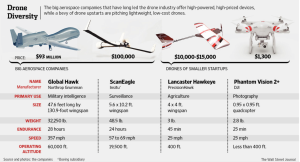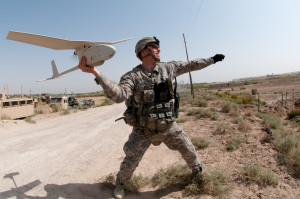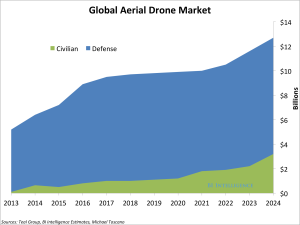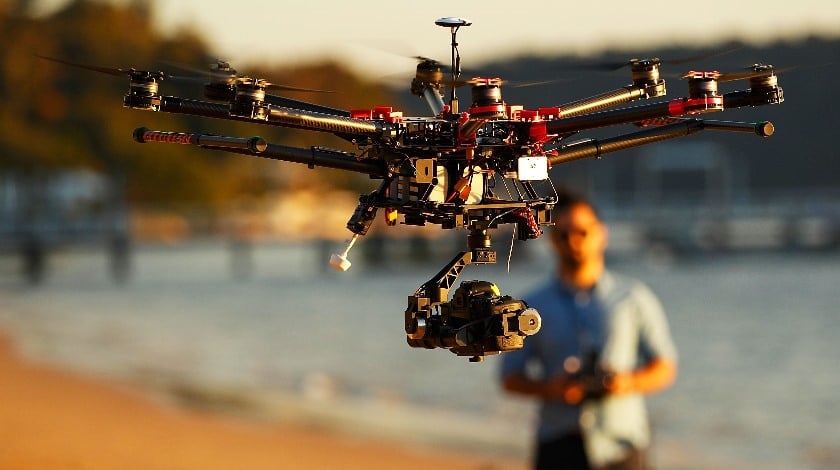Photo: icicle.org
Reading Time: 8 minutesWhen filmmaker George Lucas popularized droids – worker robots designed to tend to humanity’s every need- in the 1977 movie “Star Wars: Episode IV – A New Hope,” he seemed like a sci-fi visionary. But fast-forward nearly 40 years, and the idea of flying surveillance cameras, robotic companions and even unmanned aircraft carrying supplies around the planet is swiftly becoming mainstream. According Semiconductor and Electronics Market Research Report the global drones market is expected to reach USD 5.59 Billion by 2020, and it is expected to grow at a Compound Annual Growth Rate of 32.22% between 2015 and 2020.
There are a lot of talks about drones recently. The flying robots are part of an amazing and slightly terrifying technology that has already begun to fundamentally change our lives. The potential uses for science, agriculture, national security, public safety, personal service and entertainment are endless.
Unmanned aircraft systems (UAS) are inherently different from manned aircraft. Introducing UAS into the nation’s airspace is challenging for aviation community, because of the busy and complex airspace. The FAA, EASA and others organizations are taking an incremental approach to safe UAS integration.
Opportunities for manufacturers
Drones offer manufacturers market for their product. Sensenich Propellers recently pointed out that their new composite propeller for general aviation airplanes would be significantly more expensive if not for the increased volume the unmanned aerial systems (UAS) market brings. For businesses struggling with the depressed general aviation market, this new market is a lifeline.
One of the most under-appreciated things about the UAS movement is how radically it has shifted the focus for military research and development. Until very recently, most aerospace companies competed to make the biggest, fastest, most advanced fighter jets and the result was airplanes like the $159 million F-35 Joint Strike Fighter. Now, a lot of effort is focused on making things smaller and cheaper, not bigger and faster. The result is backpack-sized flying vehicles instead of multi-engine jets.
This matters, because general aviation has traditionally been heavily influenced by military technology (think of GPS for an obvious example). But while most of the technology on the F-35 will never make it to a Cessna, the “smaller is better” movement in UAS could lead to some more affordable improvements.

Uses of drones
Military
You have probably heard the line that the last fighter pilot has already been born, and it is mostly true. The future of military aviation is unquestionably in unmanned aircraft, from bombers to spyplanes. The latest example is Boeing’s X-47B, which just landed on an aircraft carrier.
That is bad news for anyone who wants to inspire the next generation of pilots. Drones may not replace airline pilots anytime soon, but that does not mean there will not be serious changes in the number of professional pilots.
Reason UAS is attractive for military is that it does more to keep pilots safe against modern air defenses. Without a pilot in the plane to protect, another approach to anti-air weapons becomes viable: simply overwhelm the defenses with cheap swarms of disposable drones. Both the U.S. Air Force and Defense Advanced Research Projects Agency (DARPA) are researching cheap deadly drone swarms for the future that could take out both ground weapons and enemy airplanes.
Someday, cheap and deadly or stealthy and autonomous drones may reshape the balance of power between nations, but until then it is best to focus on the impact drones will have in irregular war.
Commercial use
There are an increasing number of reports about commercial use of drones. Besides threatening military pilot jobs, drones will seriously impact other segments of aviation: agricultural application, mail delivery and firefighting…
Between now and 2050 the world’s food system will need to produce 70 per cent more food to feed an increasingly crowded world, says the Food and Agriculture Organisation of the United Nations. Ag-tech with its proliferation of novel, high-tech data gathering techniques – whether drones, sensors or GPS tracking devices – has the tools unlocking the next wave of productivity needed to keep agriculture competitive. From driverless tractors, to drones to monitor crop health and Uber-style ride-sharing apps for ferrying fresh produce, Australian researchers and farmers are experimenting with all sorts of data-driven applications to drive down costs and optimise land and water use.
Deliver shipments is a hard and time required job. While initially appearing as a gimmick drone, these Japanese-produced messenger drones have LED lights on the tip of their rotor-blades that display pre-programmed messages when they rotate. These drones could be used to pass messages in a dangerous environment. A French-made postal drone called Parrott is also being tested to deliver mail and newspapers.
“The UAV is a game changer for Incident Commanders. In a matter of minutes we can get a full view of an incident from the air allowing us to deploy resources quicker and make decisions based off what we see from a live feed,” for Drone Life News said fire chief Jerry Streich, a founding board member of Drone Advocates for Public Safety (DAPS). A real-time monitoring system in France has been developed by Fly-n-Sense and is being used in the countryside to monitor fire outbreaks and the spread of flames. Lightweight unmanned aircraft are also being designed to help tackle the biggest and most fierce fires. It will help control the fire quickly and protect the human health.
In Cushing, Oklahoma – the oil crossroads of the world – construction contractors like Aerial Data Service, Inc. used to hire helicopters to fly over oil tank construction sites for visual inspection. These helicopter flights were not only notoriously expensive, but also only provided a handful of images from a few limited angles. But through a new partnership with Hover Visions drone photography and video services, Aerial Data Service, Inc. is now able to use the DroneDeploy Android app to easily plan and automatically fly a DJI Inspire 1 to capture and instantly process all the required aerial images. In fact, their first Inspire 1 flight only took 15 minutes to cover an entire 18 acre storage tank construction site.
More than innovations
Jim Williams, who until last June was the FAA’s top drone official and who now advises drone companies for the law and lobbying firm Dentons, said it was “theoretically possible,” but unlikely, that a drone could bring down a commercial aircraft. He said the dangers got “a little more serious” for small private planes and helicopters because, among other reasons, they were more fragile than jetliners.
Other experts such as Scott Strimple, a United Airlines pilot for 25 years and an experienced drone operator, expressed deeper concerns. In a collision with a Cessna or another small plane, “a drone could easily come through the window and kill the pilot. It is just Plexiglas,” Strimple said. “That is like a frozen chicken coming through at 50 knots.” A drone, Strimple said, also could cause an engine shutdown or a cracked windshield on a larger aircraft.
A collision with even a lightweight drone could result in serious and expensive problems. A small drone impacting an engine would be unlikely to cause a crash, but it could easily cause the failure of that engine and millions of dollars of damage. Windscreens and other components are vulnerable as well. Small drones are invisible to air traffic control and onboard radar.
Most simply drones weigh less than ten pounds and do not fly very high, but bigger, heavier machines are out there, and we will be seeing more of them: paramilitary border patrol drones; police departments surveillance drones. It is these larger drones that are of greatest concern. If an operator should lose control of one of these things, or it otherwise wanders into airspace it should not be in, the results could be deadly – particularly if the collision were to damage the plane’s control surfaces, stabilizers, tail or cockpit. A jetliner traveling at 250 miles per hour (in the U.S., that is the maximum speed when flying below 10,000 feet) hitting a 25-pound UAV creates about 40,000 pounds of impact force.
One of the most common worries among critics, though, is how drone technology has enabled novices with no background in aviation to fly devices that could create havoc in the air.
“They have no situational awareness or appreciation for safety,” said Ella Atkins, a professor of aerospace engineering at the University of Michigan. “They think it is a game. They do not realize it is for real.”

Regulations
The 2.8 pound drone, advertised as “easy to fly”. Soon after takeoff, the drone veered dangerously toward a power line. It then climbed more than 700 feet – right into the path of a California Highway Patrol helicopter. A head-on collision was averted only after the chopper’s crew made a sharp right-hand turn at the last moment.
The harrowing episode illustrates a growing safety concern as more and more drones, particularly ones used for recreation, take flight into the national airspace.
The FAA enacted a mandatory registration process for all UAVs weighing more than half a pound in United States. The fee is five dollars. Will all hobbyists comply with this program? Probably not, but its purpose is less about tracking drone users than it is about creating awareness. The problem all along has been mostly one of ignorance: many users do not simply realize how hazardous a collision between an airplane and a drone could be. This mindset needs changing, and the registration program is a step in that direction. More than coming up with technical fixes or enforcing complex airspace rules, we need to encourage common sense.
Some critics focus the blame on the companies that market drones for recreational use, which can sell from under $100 to $3,000 or more. These drones can zoom to impressive altitudes but, the critics say, usually lack the navigation and communications systems and design quality needed to ensure safe flying.
UAV are increasingly being used in Europe, but under a fragmented regulatory framework. Basic national safety rules apply, but the rules differ across the EU and a number of key safeguards are not addressed in a coherent way. In 2016 and 2017, new rules will be developed, or existing ones will be amended, within the framework described in the Technical Opinion. Also, guidance material, including safety promotion, will become available.
Future steps
Edd Gent prepared article about The Future of Drones, with comments from practice director for robotics at the technology consulting firm ABI Research Dan Kara. “There’s been even more explosive growth of UAV drones market than I expected,” said director. And because the technology is still in its infancy, Kara said, the potential is limitless. “There will be applications that will just come over the wall,” he told. “If you think of these things as basically just airborne mobile sensors, all kinds of uses open up.”
An industry report released by Drone Analyst, titled “Commercial Drones: Current State of the US Industry,” noted that investments in drone technology from January 2015 through May 2015 totaled $172 million — more than the total from the previous five years combined. Most of this money came from venture capital investments, but technology companies such as GE, Qualcomm and Intel are also piling in, convinced that wirelessly connected drones could one day be a part of the Internet of Things, a network of Web-connected devices like washing machines and cars that communicate with one another.

One thing’s for sure – drones aren’t going away. There’s no use ignoring them or wishing they hadn’t been invented. As an industry, we need to embrace the changes that will benefit our flying and fight the changes that will restrict it. What began as military controversy has now become more of a conversation about making our lives easier at home.

